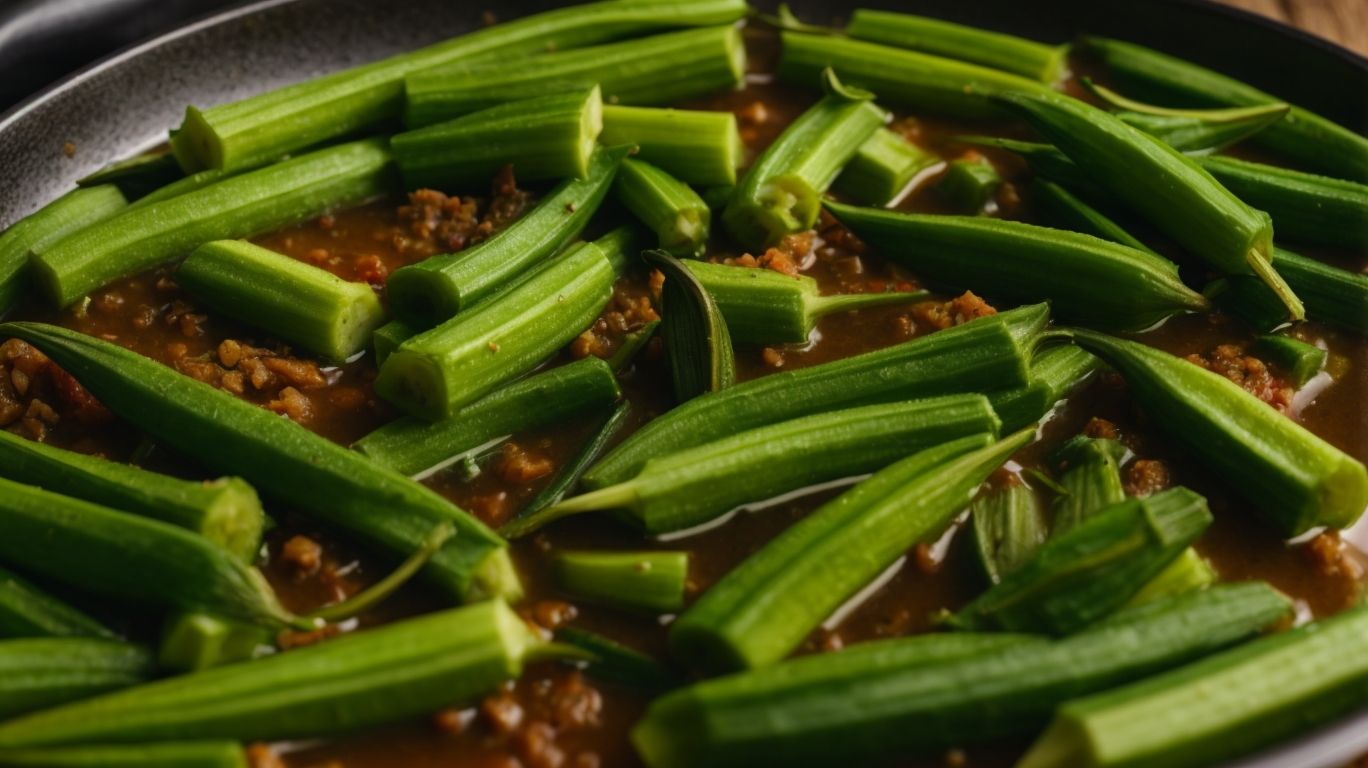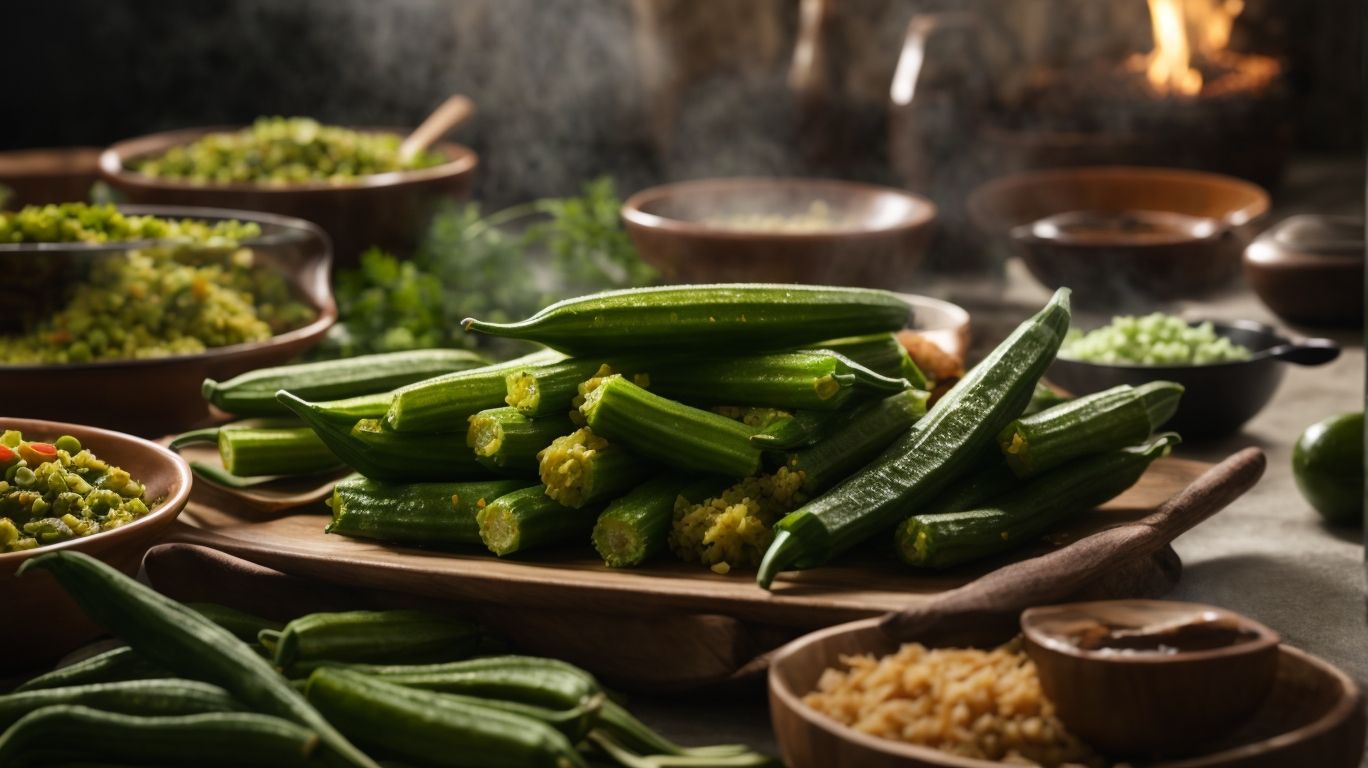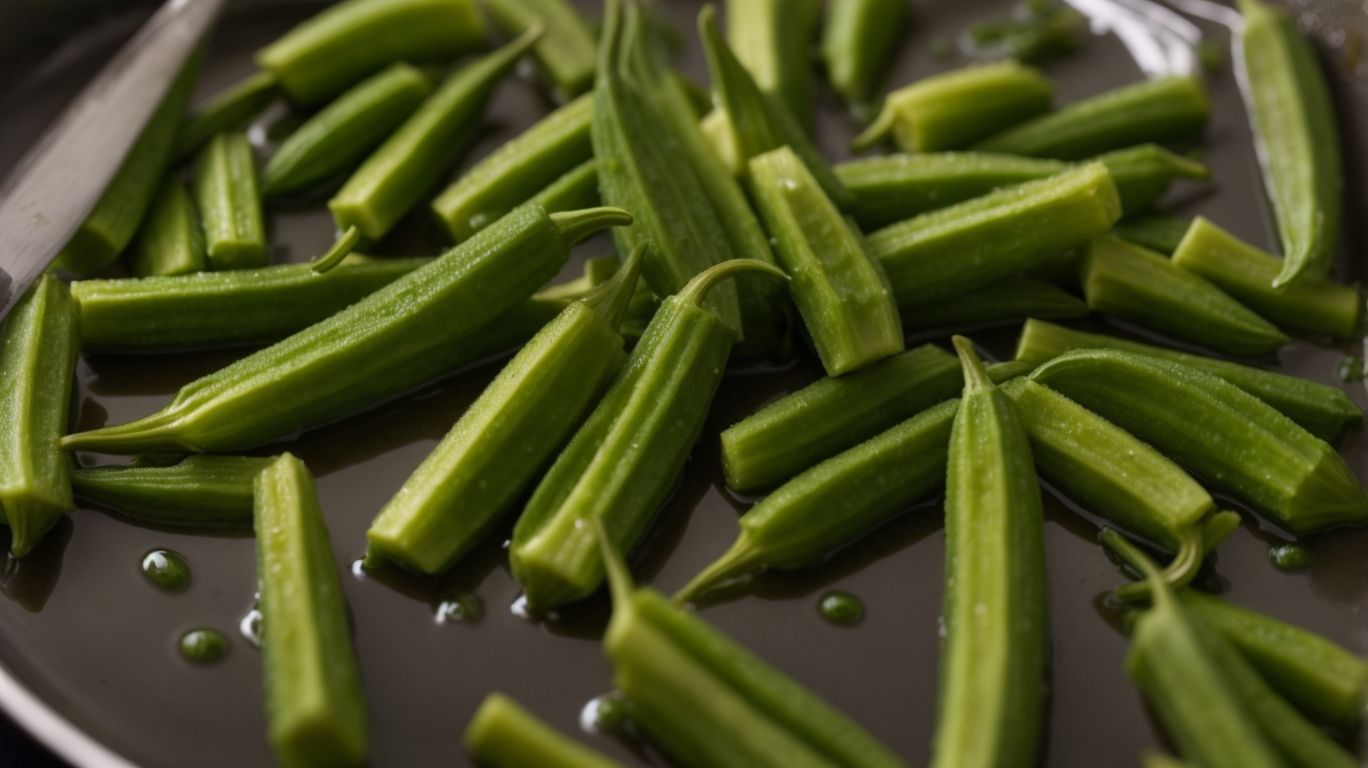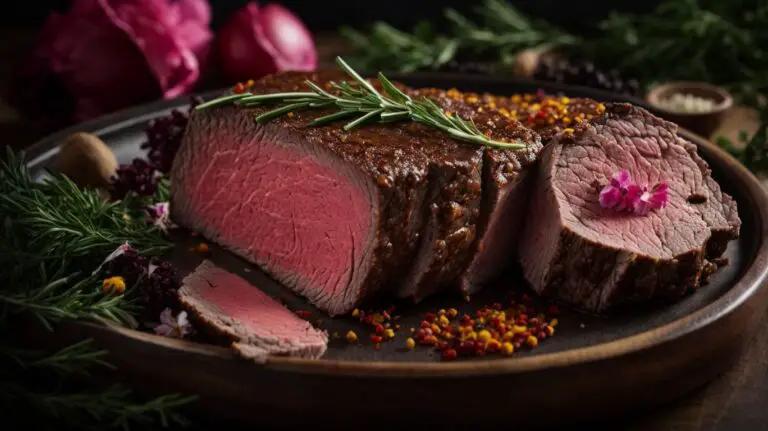How to Cook Okra Without the Slime?
Okra, also known as lady’s fingers, is a versatile vegetable that is loved by many. One common complaint about okra is its slimy texture when cooked. But there are ways to cook okra without the slime!
In this article, we will explore why okra gets slimy and provide you with 10 tips on how to cook okra without the unwanted gooeyness. We will also share some delicious recipes for cooking okra in a variety of ways.
Stay tuned to learn how to enjoy okra without the slime!
Key Takeaways:
What is Okra?
Okra, also known as lady’s fingers or gumbo, is a green flowering plant valued for its edible pods that are often used in various culinary dishes.
Okra is a vegetable that is loved for its unique texture and flavor profile. These slender pods are a good source of essential vitamins and minerals like Vitamin C, K, and folate. When cooked, okra becomes tender and slightly slimy, which many people find appealing in dishes like gumbo, stews, and curries. Its versatility in cooking allows it to be fried, pickled, roasted, or used in soups and salads. In many cultures, okra holds cultural significance and is a staple ingredient in traditional dishes.
Why is Okra Slimy?
The sliminess of okra, attributed to its mucilage content, is a natural trait that can be polarizing in culinary preparations due to its unique texture.
Okra’s mucilage, a gel-like substance found in the vegetable’s pods, acts as a natural thickener when cooked. This mucilage is released when okra is sliced or cooked, creating the characteristic viscous texture that puts off some individuals while intriguing others. The presence of mucilage is what gives okra its slimy consistency, which can be challenging to work with in certain recipes but is highly valued in dishes where thickening or textural enhancement is desired.
Cooking Okra Without the Slime

Credits: Poormet.Com – Scott Gonzalez
When preparing okra without the undesirable sliminess, various techniques and cooking methods can be employed to achieve a crispy and flavorful outcome, especially in Southern-inspired recipes.
Choose the Right Okra
Selecting fresh and young okra pods is crucial to minimize sliminess, ensuring that the slicing process yields optimal results in your culinary endeavors.
When shopping for okra pods, look for ones that are firm to the touch and vibrant green in color, indicating their youthfulness. Freshness plays a key role in the tenderness and flavor of the pods. The younger the pod, the less likely it is to develop a slimy texture when cooked.
Once you’ve chosen the perfect okra pods, the slicing technique is equally important in preparing them for your dish. Aim for uniform slices to promote even cooking and a more visually appealing presentation. Avoid overhandling the pods as this can release excess mucilage, leading to unwanted stickiness.
Wash and Dry Okra Properly
Before preparing okra, it is essential to wash and thoroughly dry the pods to remove any dirt or residue that could affect the final texture and taste of the dish.
Properly washing okra not only eliminates any potential contaminants but also helps reduce the sliminess that is often associated with this vegetable. Drying the okra is equally crucial, as excess moisture can lead to a mushy consistency when cooked. One effective method is to pat the washed pods dry with a clean kitchen towel or use a salad spinner to remove excess water.
For those looking to retain crispy texture in their okra recipes, it is advisable to slice the pods only after ensuring they are completely dry. This step is particularly important when frying or roasting okra to achieve a satisfying crunch.
Cut Okra in a Certain Way
The technique of slicing okra in a specific manner can help avoid excessive sliminess during cooking, resulting in a more enjoyable texture and presentation.
One effective way to reduce the slimy texture of okra is to slice it relatively thin, about a quarter-inch thickness. This thin slicing method exposes more surface area of the okra to heat, which helps dry out the mucilage, the substance responsible for the sliminess. Additionally, dusting the sliced okra with a bit of cornmeal or flour before cooking can further absorb excess moisture and prevent the slippery texture. This coating also helps in creating a crispy exterior while retaining a tender interior, enhancing the overall dining experience.
Use High Heat and Short Cooking Time
Cooking okra at high heat with short cooking times can help reduce sliminess and enhance its natural flavors, showcasing the versatility of this vegetable in various culinary techniques.
When okra is cooked quickly at high temperatures, it minimizes the release of mucilage, the substance responsible for the characteristic sliminess. This technique not only improves the texture of the dish but also retains more of the vegetable’s distinct flavor profile.
The rapid cooking process preserves the vibrant green color of okra, making dishes visually appealing and appetizing. The high heat caramelizes the natural sugars in okra, adding a delightful depth of flavor and aroma to the final dish, enriching the overall culinary experience.
Add Acidic Ingredients
Incorporating acidic ingredients such as tomatoes, vinegar, or citrus juices can help balance the slimy texture of okra, providing a tangy and refreshing flavor profile in your dishes.
Tomatoes, with their natural acidity and sweetness, not only help in reducing the mucilaginous properties of okra but also add depth to the overall taste. When combined with vinegar or citrus juices, such as lemon or lime, the acidic elements work synergistically to cut through the inherent sliminess of okra.
The acidity from these ingredients brightens the dish, making it more vibrant and appetizing. The tanginess that they impart complements the earthy notes of okra, creating a well-rounded flavor profile.
Cook with Other Vegetables
Combining okra with other vegetables in dishes like gumbo or Creole-inspired recipes can create harmonious flavor profiles while mitigating its sliminess through diverse culinary combinations.
When cooked alongside tomatoes, onions, bell peppers, and celery, okra not only adds a unique texture but also enhances the overall taste of the dish. The subtle sweetness of the tomatoes complements the earthiness of okra, while the onions and bell peppers bring a depth of flavor. In dishes like gumbo, the combination of these vegetables creates a rich, complex flavor that is characteristic of Creole cuisine.
The mucilaginous properties of okra that can sometimes deter people from using it in cooking are greatly reduced when combined with acidic ingredients like tomatoes. This results in a velvety texture without the excessive sliminess that some may find offputting. By incorporating okra into vegetable medleys, you can elevate the nutritional content of your meals while enjoying a delicious and satisfying dining experience.
Use a Non-Stick Pan
Opting for a non-stick pan when cooking okra can prevent excessive sticking and aid in achieving a desirable texture without the need for excessive oil or additional fats.
By using non-stick cookware, you can ensure that the okra retains its natural moisture and flavor without the risk of it getting mushy or overly greasy. The non-stick surface promotes even heat distribution, allowing the okra to cook evenly and develop a crispy exterior while maintaining a tender interior. With non-stick pans, you can significantly reduce the amount of oil or butter needed for cooking, making your okra dishes healthier without compromising on taste.
Try Different Cooking Methods
Experimenting with various cooking methods like grilling, frying, sautéing, or dry roasting can offer diverse textures and flavors in okra dishes, providing culinary versatility.
Grilling okra can impart a smoky flavor and slightly charred exterior, enhancing its natural earthiness.
Frying okra results in a crispy exterior while retaining a soft interior, creating a delightful contrast in every bite.
Sautéing okra in a pan with spices and aromatics allows for a quick cooking process that maintains its tender texture.
Dry roasting okra brings out its nutty undertones and intensifies its flavors without added oil, making it a healthier cooking option.
By trying different methods, one can discover the unique characteristics and tastes that okra can offer in various culinary creations.
Add Salt at the End of Cooking
Adding salt towards the end of the cooking process when preparing okra dishes can help control its texture and sliminess, ensuring a well-seasoned and enjoyable culinary outcome.
By delaying the addition of salt until the okra is almost cooked, you allow the flavors to develop fully and penetrate the dish. This step prevents the natural mucilage of okra from becoming overly pronounced, resulting in a more pleasant mouthfeel. Seasoning at the end enables you to adjust the saltiness precisely according to taste, as some ingredients can release more liquid during cooking, affecting the overall salt levels. This practice showcases how strategic salt usage in cooking plays a crucial role in balancing flavors and achieving the desired dish profile.
Avoid Overcooking
Avoiding overcooking okra is essential to maintain its desired texture and flavor, ensuring that this versatile vegetable retains its nutritional value and visual appeal.
When okra is overcooked, it tends to become slimy and loses its vibrant color, turning mushy and unappetizing. By cooking okra for just the right amount of time, you can savor its crunchiness and subtle natural sweetness. Proper timing is crucial when preparing okra dishes, as it aids in showcasing the unique taste and texture of this vegetable.
Recipes for Cooking Okra Without the Slime

Credits: Poormet.Com – Bryan Carter
Exploring diverse recipes for cooking okra without the undesirable sliminess opens up a world of culinary possibilities, from crispy fried okra to flavorful pickled variations and hearty Creole-inspired stews.
Fried Okra
Fried okra, seasoned with aromatic spices like cayenne pepper and cumin, offers a crispy and indulgent dish that highlights the versatility of this beloved vegetable.
Preparing fried okra with these flavorful spices involves a simple yet effective process. Start by slicing fresh okra into bite-sized pieces. In a bowl, mix together a combination of cornmeal, flour, cayenne pepper, cumin, salt, and pepper. Coat each okra piece thoroughly in this seasoned mixture, ensuring an even distribution of spices.
- Next, heat oil in a skillet over medium-high heat until it shimmers. Carefully place the coated okra into the hot oil, being mindful not to overcrowd the pan. Fry the okra in batches to maintain crispiness.
- Allow the okra to fry until golden brown and crispy, stirring occasionally to ensure even cooking. Once perfectly fried, remove the okra from the oil and place it on a paper towel-lined plate to absorb any excess oil.
The result is a delightful dish that combines the natural sweetness of okra with the bold flavors of cayenne pepper and cumin, creating a satisfying crunch with every bite.
Roasted Okra
Roasting okra in the oven through dry roasting techniques can yield a deliciously crisp and golden-brown result, perfect for a healthy and flavorful side dish or snack.
When roasting okra, it is essential to preheat the oven to ensure the vegetables cook evenly. The first step involves washing and drying the okra thoroughly to remove any excess moisture, which helps in achieving that desired crispy texture. After cutting the okra into bite-sized pieces, a light drizzle of olive oil is enough to coat them for roasting. Seasonings such as salt, pepper, and a sprinkle of paprika can be added to enhance the flavor profile.
Pickled Okra
Pickling okra in vinegar brine can transform this vegetable into a tangy and versatile condiment, perfect for adding zing to salads, sandwiches, or charcuterie boards.
When pickling okra, the acidity of the vinegar helps enhance the natural flavors of the vegetable while preserving its crunchiness. The process involves soaking okra pods in a vinegar-based solution infused with aromatic spices like mustard seeds, garlic, and dill, providing a unique depth of flavor.
Aside from being a delicious accompaniment to various dishes, pickled okra can also be enjoyed as a standalone snack or appetizer. Its tangy taste pairs well with cheeses and cured meats, making it a popular choice for cheese platters or antipasto trays.
Okra and Tomato Stew
Preparing a hearty okra and tomato stew with Creole influences and aromatic spices like chile can result in a rich and comforting dish that celebrates the flavors of the South.
Traditionally, a Creole-inspired okra and tomato stew starts by heating a pot with a drizzle of oil before adding a flavorful base of onions, bell peppers, and celery, known as the holy trinity in Creole cooking. The medley of these vegetables creates a harmonious flavor foundation in the stew.
Next, sliced okra is added to the pot, giving the stew a unique texture and thickening quality. The okra’s natural gooey consistency is perfect for stews, helping to create a luscious and hearty dish.
Grilled Okra Skewers
Grilling okra on skewers over high heat with a blend of spices can yield smoky and charred flavors that elevate the natural sweetness of this versatile vegetable, creating a delightful summer dish.
When grilling okra skewers during the summer months, it’s important to choose firm, fresh okra pods to ensure a satisfying texture once cooked. To achieve that perfect charred exterior, consider marinating the okra in a mixture of olive oil, paprika, cumin, and a hint of cayenne pepper to add a depth of flavor.
As the skewers hit the grill, the spices mingle with the heat, infusing the okra with a tantalizing aroma that will have your taste buds dancing. Remember not to overcrowd the skewers to allow for even cooking and that desired smoky essence.
Frequently Asked Questions
What is okra and why does it have slime?
Ans: Okra is a vegetable that is commonly used in dishes from Southern and Asian cuisines. The slime comes from the natural mucilaginous substance found in the okra pod.
Why do some people prefer to cook okra without the slime?
Ans: The slime in okra can be off-putting to some people, and cooking it without the slime can result in a less slimy and more enjoyable texture.
How can I cook okra without the slime?
Ans: There are several methods for cooking okra without the slime, such as frying, roasting, or pickling the okra. These methods help reduce the slime and give the okra a delicious flavor.
Can I remove the slime from okra before cooking?
Ans: Yes, you can reduce the amount of slime in okra by soaking it in vinegar or lemon juice before cooking. This will help break down the slime and make it easier to cook without the slime.
What are some tips for cooking okra without the slime?
Ans: It’s important to not overcook okra, as this can result in a slimy texture. It’s also helpful to dry the okra thoroughly before cooking and to cook it at a high heat, which will help reduce the slime.
Is there a specific type of okra that is less slimy?
Ans: Yes, the younger, smaller okra pods tend to be less slimy than larger, more mature pods. If you’re looking for a less slimy okra, try to find smaller pods at the grocery store or farmers’ market.





